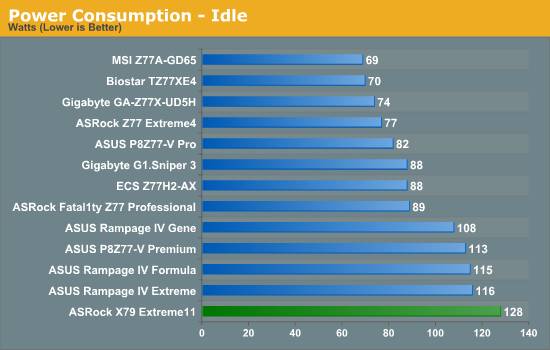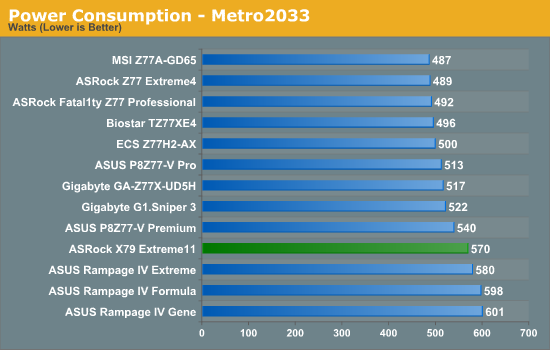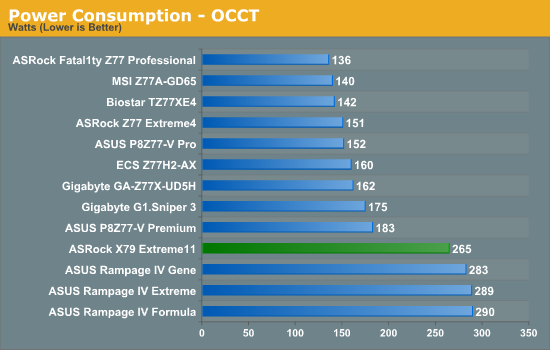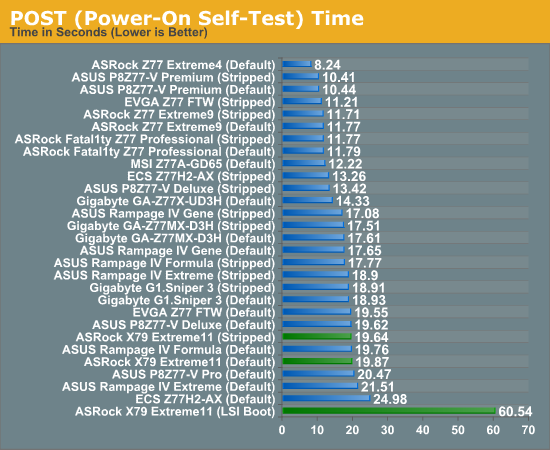ASRock X79 Extreme11 Review: PCIe 3.0 x16/x16/x16/x16 and LSI 8-Way SAS/SATA
by Ian Cutress on September 3, 2012 10:15 AM EST- Posted in
- Motherboards
- ASRock
- X79
- LSI
- PLX
Many thanks to...
We must thank the following companies for kindly donating hardware for our test bed:
OCZ for donating the Power Supply and USB testing SSD
Micron for donating our SATA testing SSD
G.Skill for donating our memory kits
ASUS for donating AMD GPUs and some IO Testing kit
ECS for donating NVIDIA GPUs
ASRock and ADATA for organizing loan of the RAID SSDs
Test Setup
| Processor | Intel i7-3960X (6C/12T, 3.3 GHz) |
| Motherboards | ASRock X79 Extreme11 |
| Cooling | Intel All-In-One Liquid Cooler |
| Power Supply | OCZ 1250W Gold ZX Series |
| Memory | GSkill RipjawsZ 4x4 GB DDR3-2400 9-11-11 Kit 1.65 V |
| Memory Settings | XMP |
| Video Cards |
ASUS 7970 3GB GDDR5 ECS GTX 580 1536MB |
| Video Drivers |
Catalyst 12.3 NVIDIA Drivers 296.10 |
| Hard Drive |
Corsair Force GT 60GB Micron RealSSD C300 256GB |
| Case | Open Test Bed - CoolerMaster Lab V1.0 |
| Operating System | Windows 7 64-bit |
| SATA Testing | Micron RealSSD C300 256GB |
| RAID Testing | ADATA SX910 256GB |
| USB 2/3 Testing | OCZ Vertex3 240GB |
Power Consumption
Power consumption was tested on the system as a whole with a wall meter connected to the OCZ 1250W power supply, while in a dual 7970 GPU configuration. This power supply is Gold rated, and as I am in the UK on a 230-240 V supply, leads to ~75% efficiency > 50W, and 90%+ efficiency at 250W, which is suitable for both idle and multi-GPU loading. This method of power reading allows us to compare the power management of the UEFI and the board to supply components with power under load, and includes typical PSU losses due to efficiency. These are the real world values that consumers may expect from a typical system (minus the monitor) using this motherboard.



Despite the fact that the PLX chips can be power gated when not in use, at idle there is still a little overhead in power usage from the PLX+LSI combination. Nevertheless, the additional power required by the ASUS ROG boards at loading means that the ASRock draws less power during both Metro 2033 and OCCT.
POST Time
Different motherboards have different POST sequences before an operating system is initialized. A lot of this is dependent on the board itself, and POST boot time is determined by the controllers on board (and the sequence of how those extras are organized). As part of our testing, we are now going to look at the POST Boot Time - this is the time from pressing the ON button on the computer to when Windows starts loading. (We discount Windows loading as it is highly variable given Windows specific features.) These results are subject to human error, so please allow +/- 1 second in these results.

Unlike other ASRock motherboards, the X79 Extreme11 actually has a long time to boot. Even longer if you decide to boot from the LSI chip, or have Intel RAID arrays present.










62 Comments
View All Comments
cjs150 - Tuesday, September 4, 2012 - link
All those right angled, stacked SATA connectors and the 24 pin ATX connector is still sticking straight up!Come on, it costs little to make this a right angled connector and makes for much better cable management (especially if you are also using all the SATA connectors)
Has anyone checked the accuracy of the ASRock Hardware monitor for temperatures? There are reports that on other ASRock board these are significantly inaccurate.
Ultimately other than M/B p#rn not really sure what market this board is aimed at. For a workstation I would prefer dual CPUs and 48 PCI lanes
dgingeri - Tuesday, September 4, 2012 - link
I think that LSI 2308 chip is the same as the chip used in Dell's PERC H310 controller, with slightly different firmware/bios. (Dell customizes theirs to call it a PERC and label it as a Dell controller, but it is still labeled as a LSI copyright.) If so, that's a very good controller, from my experience.ComputerGuy2006 - Tuesday, September 4, 2012 - link
I want Ivy Bridge-E, not going to go from 1336 setup to x79 setup without knowing if ivy-e is even coming out (much less if it will work on the same mobo)dgingeri - Tuesday, September 4, 2012 - link
With AMD providing absolutely no competition in this space, I would say it is unlikely they'll come out with any updates worthy of spending money. Think of the time with the P4 while AMD wasn't providing competition. Intel put out processors from 2.8 to 3.8GHz over the course of 2 years which cost more and gobbled up more electricity, yet provided minimal performance enhancement. (iirc, the 3.8GHz chip was only about 10% faster than the 2.8GHz chip because of memory bandwidth limitations and thermal throttling, yet Intel charged more than double the intro price than the 2.8GHz for the 3.8GHz chip.) Intel without competition is just a money hog, gobbling up more and more money with little to show for it. I doubt Haswell with be anything special, either. IB certainly isn't.Oh, yeah, they say Haswell will be 10% faster than IB at the same clock rate. While AMD was providing competition, they were putting out things that ran 50-60% faster per clock, and had faster clock rates to boot. So, at the price point, we'd get a 75-100% boost per generation. (Core 2 had a drop in clock rate, sure, but it was WAY faster than the P4, giving us a 80%+ performance boost at the same clock rate. Coppermine was a huge boost in both clock rate and efficiency. Katmai was a huge boost in clock rate and efficiency. Same with Klamath and Deschutes. Yet, the P4 generation was a huge stall point, and also the point where most of Intel competitors got out of the race and AMD was way behind.)
I wish someone would come into the market and provide an little incentive to get Intel to move their butts forward, but we're not going to see that for probably another decade.
Master_shake_ - Tuesday, September 4, 2012 - link
problem is Intel won't allow any more companies to get the x86 license to make desktop/notebook cpus.i want Nvidia to make one just to have a 3rd choice.
fteoath64 - Thursday, September 6, 2012 - link
"i want Nvidia to make one just to have a 3rd choice.".Yeah, then Nvidia buys VIA and starts making NV-nano as the Tegra3 of x86 for the super tablets that would be weight compatible with current 10.1 Android/iOS tablet ..... {pipe dream ...}
Nvidia doing a x86 and ARM hybrid processor would be really cool for a new generation of UltraBooks that does Win8 and Android together. Imagine when docked you have both Win8 (external monitor) and ICS/JB on tablet with touch. Win8 tablets being much thicker plas plenty of space for 2 SDcard slots and 2 MicroSD slots.
fteoath64 - Saturday, July 12, 2014 - link
When the discrete gpu market for high-end notebooks dries up, then Nvidia might make a VIA play. For now, they cannot afford such an investment especially when they had sunk millions on Denver (Arm V8) 64-bit arm with the K1. IF they produce a great Arm 64bit core, then they might have a great chance on the tablet and high-end mobile market. Also, left over for the low-end and microserver market.Frallan - Wednesday, September 5, 2012 - link
I was complaining the other day about AT becoming an iSite talking more about iWare than anything else.My honesty compels me to write in after the last few days and apologize. There has been a number of good interesting computer and component articles the last week that proved me wrong.
Thank you AT and keep the good work up.
BlueReason - Wednesday, September 5, 2012 - link
"ASRock have potentially missed a trick here"It's becoming trendy for American-based tech blogs to use the British standard for subject/verb agreement when it comes to businesses. You could debate what it ought to be all day, but American professional writing standards dictate that companies be referred to as a singular entity. You can do whatever you like, of course, but just an fyi in case you submit a piece to a major American publication. They won't see your usage as fancy.
Razorbak86 - Monday, September 24, 2012 - link
"Lighten up, Francis." -- Sergeant Hulka, Stripes (1981).Although you may view Ian Cutress' prose as "fancy", he was hardly being pretentious. He lives in London, and he was educated at the University of Oxford. That might not mean much to you, but feel free to Google a map or two and educate yourself about world geography.
I lived and worked in the United Kingdom for 5 years as an American expatriate. My daughter was born in Aberdeen, Scotland, and my kids grew up with British accents. I can assure you that it is standard practice in the United Kingdom to refer to companies in the plural. Fortunately for me, the British people were very gracious hosts. Despite the subtle differences between my American dialect and the Queen's English, they always treated me and my family with great respect throughout our stay.
So please be a little more polite when referring to one of the Senior Editors of AnandTech. You are, after all, communicating in HIS native tongue, not yours. ;-p